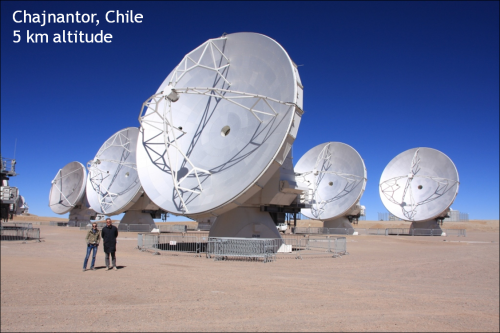Cosmic alcohol once again confirms the constancy of a natural constant

(Phys.org) —A research team led by FOM workgroup leader Prof. Dr. Wim Ubachs and Dr. Rick Bethlem has once again demonstrated that the mass ratio between electrons and protons has remained the same over the past 7.5 billion years. The group, which published this conclusion last January in Science, has recently performed a wide range of measurements that confirm their earlier finding. The new results are published on 4 December in Physical Review Letters.
The mass of a proton is 1836.152672 times as big as the mass of an electron. That ratio, and with it the structure of all molecular material, has remained precisely the same for 7.5 billion years – at least within a margin of 100,000th of a percent. Ubachs and his colleagues concluded that when they observed methanol molecules outside the Milky Way last year, using the Effelsberg radio telescope.
Cosmic alcohol
Methanol (CH3OH, the simplest form of alcohol) is sensitive to changes in the proton-electron mass ratio. A small deviation would affect the structure of the molecule and the associated absorption spectrum. An absorption spectrum reveals precisely which radiation frequencies are absorbed by a particle. Each molecule has its own characteristic spectrum. The spectrum of methanol was found to be ideally suited for analysing the natural constant: if the proton-electron mass ratio changes, some lines in the methanol spectrum will strongly shift while others will remain the same (the so-called anchor lines).
Last year the researchers analysed the spectrum of methanol molecules in a different galaxy. As the molecules are so far away, it takes a long time before their radiation reaches the Earth. In effect, the researchers were therefore looking back in time at how methanol looked 7.5 billion years ago. They saw that the 'old methanol' has a comparable spectrum to the modern methanol.
Additional measurements
The researchers have now made additional measurements using the Effelsberg radio telescope (Germany), the IRAM-30-telescope (Granada, Spain) and the new ALMA Observatory in Andes, on the Chilean-Bolivian border. As water vapour in the atmosphere disrupts the measurements at high frequencies, the researchers had to perform the measurements at these high and dry locations. While the measurements in Germany were limited to radio frequencies up to 35 gigahertz (GHz), the IRAM radio telescope observed absorption lines at 83 GHz and 160 GHz. The ALMA Observatory, about 5 km above sea level situated in the dry Atacama Desert, could even measure an absorption line at 261 GHz.
During the new research, the physicists also discovered that the direction of the radiation originating from the radio source, which is absorbed by the methanol, undergoes changes. Furthermore, they discovered that the temperature distribution of the gas cloud in which the methanol is located exerts an influence on the absorption. Thanks to the new measurements, Ubachs and his colleagues could now see sufficient spectral lines to filter the aforementioned effects out of the results.
On the basis of the ten absorption lines observed, the researchers could make an improved statistical analysis. All measurements confirm that the proton-electron mass ratio has indeed remained constant.
The research was carried out by FOM workgroup leader prof.dr. Wim Ubachs and FOM PhD researchers Julija Bagdonaite and Mario Dapra (all at VU University Amsterdam), in collaboration with colleagues at the VU University Amsterdam, the Max Planck Institute in Bonn and the Onnsala Observatory in Sweden.
More information: Robust Constraint on a Drifting Proton-to-Electron Mass Ratio at z = 0.89 from Methanol Observation at Three Radio Telescopes, Physical Review Letters, 4 December 2013.
Journal information: Science , Physical Review Letters
Provided by Fundamental Research on Matter (FOM)





















